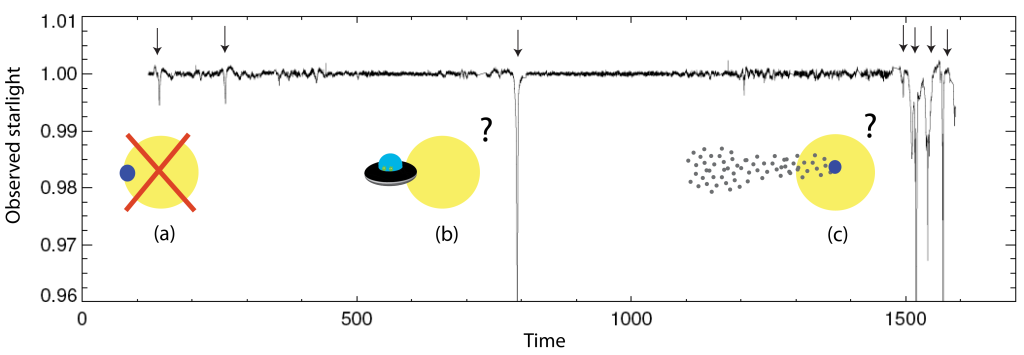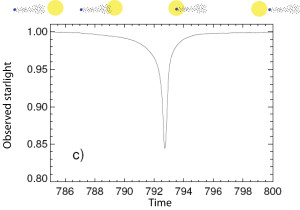The curious case of KIC 8462852 by Theodora Karalidi
Discovering the first planet, other than our Earth, that hosts life is one of the holy grails of astronomy. This is a difficult task since planets that could host life are pretty small compared to their parent star, and they are so far away from us that all the information on possible life, clouds, oceans or continents on the planet is hidden in one pixel. Theorists like myself are developing codes that model the signal of different worlds and try to match it with the signals we observe from exoplanets. Trying to get as much information as possible from one pixel is a pretty challenging, but also fun work!
Recently, amateur astronomers inspecting Kepler observations noticed something weird was happening around star KIC 8462852: the observations showed lots of dips in the star light, like one or more objects were passing in front of the stellar disk. However, the dips did not match one or more planets eclipsing their parent star. Professional astronomers took over and observed KIC 8462852 with different telescopes and instruments to try to figure out what was going on. Did it have a big disk of material around it that was blocking the starlight (like the one Kevin showed on a previous post, but edge-on)? Were these weird dips the aftermath of a huge collision of two planets, like the one that we think created our Earth-Moon system? Was it a family of comets or, more intriguingly, was it signs of an alien civilization? Could it be that the dips were due to some form of alien mega-structures passing in front of the stellar disk?

The light Kepler observed from KIC 8462852 presents a series of dips that are weirdly spaced in time (black arrows). These dips cannot be explained by one or more planets eclipsing their parent star (a). Could it be signs of aliens (b), or just an astrophysical event like comets crossing the stellar disk (c)? This figure is based on Fig.1b of Boyajian et al. (2016)
SETI, the Search for Extra Terrestrial Intelligence project, observed KIC 8462852 and tried to look for signs of an advanced civilization around the star. SETI looked for radio signals, laser pulses and visible signs of that civilization, but their efforts did not give any positive results. The case of KIC 8462852 became even more curious when an astronomer reported that after inspecting old observations spanning 100 years, he discovered that the star appeared to be dimming in an unprecedented rate. The rate at which the star was dimming could not be matched by any astrophysical mechanism, leading people to think that maybe there were aliens living around that star after all! Unfortunately for the people trying to find life on other worlds, another team of astronomers inspected the same observations again, and found that the reported dimming of KIC 8462852 was seen in other stars as well. So the dimming was not hinting to a special property of the star, but rather an inconsistent calibration of data over a century of observations.

Perhaps the most interesting dip in the light of KIC 462852. If a comet is responsible for this dip its tail should be ahead of the comet nucleus (see schematic depiction on the top)! This figure is based on Fig.1c of Boyajian et al. (2016)
Currently, the most plausible scenario is that the observed dips of KIC 8462852 are due to a family of comets orbiting the star. Astronomers tried to fit a model of a comet family to the last 100 days of the observations and found a good match! Creating such a large family of comets that could produce the series of dips we observe would need a large body breaking into pieces to become comets. The idea these astronomers proposed was that maybe there is another planet around KIC 8462852 that “pushed” the broken pieces into the comet orbits we see today. However, while they could reproduce the last 100 days of dips pretty well, they did not try to do the same with the previous dips. Approximately 700 days before the dips they chose to fit, there is an especially interesting dip. If it belongs to a comet it could mean that its tail is ahead of the nucleus, and that is not easy to explain! Aliens, comets, or something else? The mystery of KIC 8462852 is still not solved, and it looks like it will keep astronomers busy for some time to come. But that is the nature of any research. We keep on questioning our conclusions until we are absolutely sure they are true!
